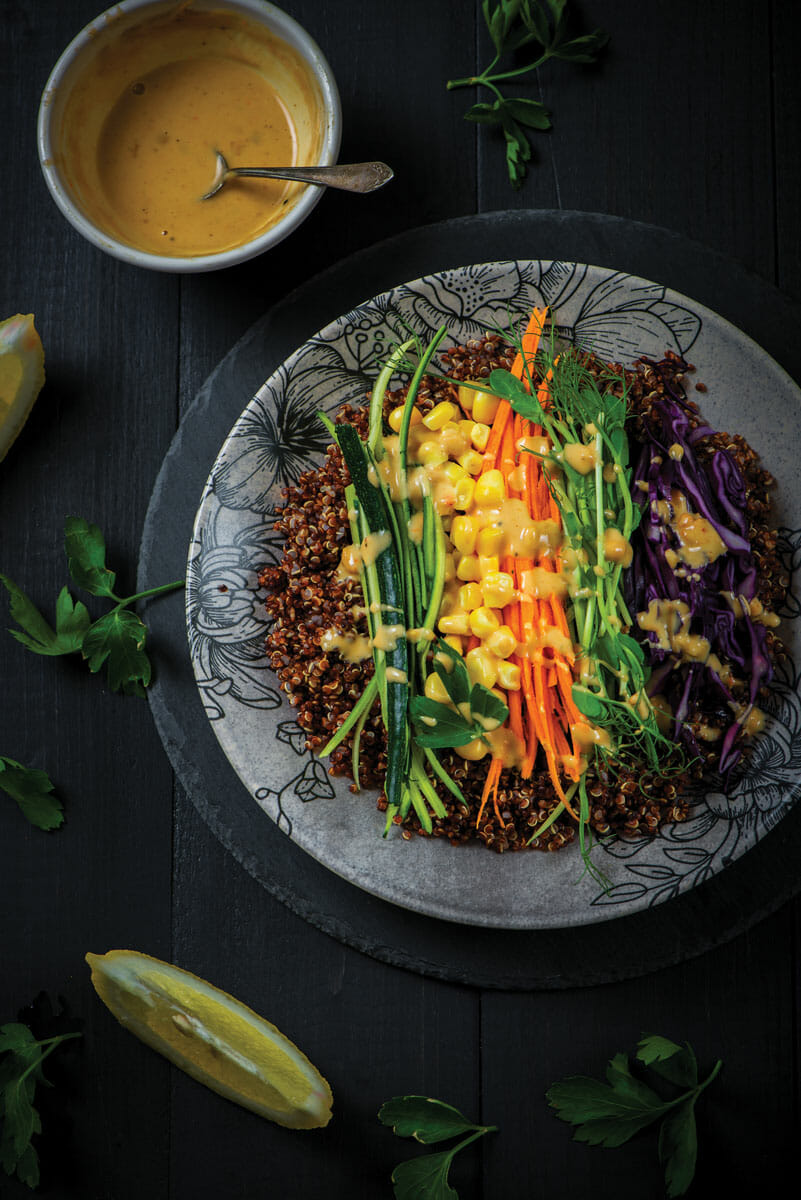Find Balance in Plant-Based Bowls as Simple Meals
Have you ever walked away from a meal craving something else about an hour later? That’s because you didn’t fulfill the body’s natural desire for all of the six tastes, as they are described in Ayurveda. When you consume a meal that contains the six tastes, you are nourished from a cellular level. Each taste corresponds with different qualities, as well as with macro and micronutrients. Including them all in a meal helps you to feel whole and balanced.
The reason fad diets don’t work is because they often skip out on or reduce the most essential taste, sweet. This can lead you to crave unhealthy sources of sweet after finishing a meal—such as that tempting brownie you see in the case at the coffee shop. By including a healthy source of sweet in a dish, such as quinoa, root vegetables, or healthy fats, you won’t crave desserts after licking your bowl clean.
According to Ayurveda, lunch is the time where your digestive fire, known in Sanskrit as agni, is the highest level of the day. Lunch is the best time to indulge in a Six Taste Plant-Based Bowl.
Customize Your Six Taste Bowl
Customize your Six Taste plant-based bowl by increasing or decreasing portions of the individual tastes. You may want to choose larger portions of the tastes that pacify your primary dosha and smaller portions of the tastes that increase it. All six tastes should still be present, however. If you feel balanced in the moment, just consume the bowls as is according to the recipe.
The six tastes in Ayurveda are as follows: Sweet, Salty, Sour, Pungent, Astringent, and Bitter.
To balance Vata: Include more sweet, sour, and salty tastes.
Decrease bitter, pungent and astringent tastes.
To balance Pitta: Include more sweet, bitter, and astringent tastes.
Decrease sour, salty, and pungent tastes.
To balance Kapha: Include more bitter, pungent, and astringent tastes.
Decrease sweet, sour, and salty tastes.
The Basic Components of a Six Taste Bowl
Hearty Base: Cooked grains and/or roasted starchy vegetables
+
Colorful Veggies: Variety of colors steamed, roasted, or raw
+
Plant Protein: Legumes, nuts, seeds
+
Healthy Fats: Avocado, coconut, nuts/nut cheeses, dressings made with nut butters and plant-based oils
+
Pungent Spices: Turmeric, cumin, and classical Ayurvedic spices; optional onion/garlic
+
Tasteful Garnishes: Fresh herbs + microgreens, sprinkle of sea salt, squeeze of lime
Hearty Base: Sweet
Quinoa
Starchy vegetables: sweet potato, pumpkin, butternut squash, carrot, corn
Brown rice, barley or other grain
Colorful Veggies: Bitter
Leafy greens: spinach, arugula, collard greens
Cruciferous vegetables (cauliflower, broccoli, cabbage, Brussels sprouts, kale)
Other vegetables: zucchini, snow peas, bell pepper, cucumber
Plant Protein: Astringent
Legumes: lentils, black beans, chickpeas, adzuki beans, edamame
Nuts and seeds: sesame seeds, tahini, sunflower, chia, flax seeds, walnuts
Healthy Fats: Sweet
Avocado, coconut
Nut cheeses, almonds, cashews
Plant-based oils: sesame, coconut, olive, avocado, grapeseed
Spices: Pungent
Allium vegetables: garlic, onion, leek, scallion, shallot
Spices: Cumin, turmeric, ginger, asafetida, black pepper
Garnishes: Salty and Sour
Salty: Sea salt, coconut aminos, sea vegetables, celery
Sour: Lemon, lime, apple cider or coconut vinegar
Quinoa Gado-Gado Bowl
Serves 2
Ingredients
For the Gado-Gado
½ cup red quinoa, well rinsed and drained
1 cup water
1 cup green beans, washed and trimmed
½ zucchini, thinly sliced
1/8 cup non-gmo corn kernels
1/8 carrot, thinly sliced
¾ cup mung bean sprouts
2/3 cup thinly shredded red cabbage
For the Spicy Sunbutter Sauce
1/3 cup sunflower seed butter
1 tbsp tamari
2 tbsp maple syrup
3 tbsp lime juice
1 tsp chili garlic sauce (remove to calm pitta)
3 tbsp water, to thin
For Serving:
¼ cup cilantro, chopped
1 lemon, cut in wedges
Instructions
Heat a small saucepan over medium heat and add quinoa. Toast quinoa for three minutes while stirring frequently. Then add water, stir, and bring to a boil. Reduce heat to a simmer, cover, and cook for 20 minutes until all the liquid is absorbed and quinoa is tender. Fluff with a fork, remove lid, and remove from heat.
Make the sunbutter sauce by adding the sunflower seed butter, tamari, maple syrup, lime juice, and optional chili garlic sauce to a small mixing bowl and whisk until smooth. Add water 1 tbsp at a time until a semi-thick but pourable sauce is formed.
To serve, divide the quinoa in two bowls, top zucchini, corn, carrot, mung bean sprouts, and red cabbage. Top with sunbutter sauce, cilantro, and lemon.
Read more Ayurvedic Recipes and Suggestions from Sahara Rose.
Sahara Rose is an Ayurvedic practitioner, sports nutritionist, holistic health coach, and author of the Idiot’s Guide to Ayurveda, She leads a 12-week program bringing a combination of Eastern and Western health philosophies into busy lives. Sahara offers a free Ayurvedic Mind-Body type quiz at: iamsahararose.com

